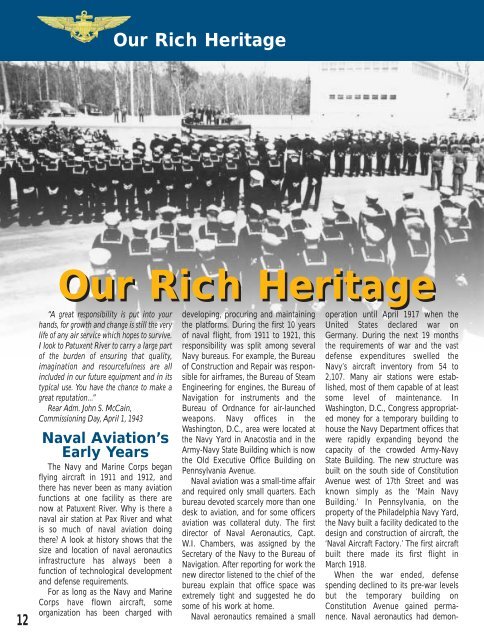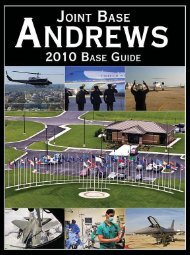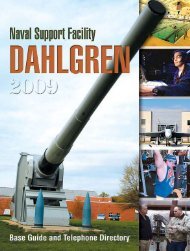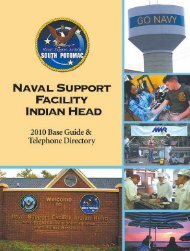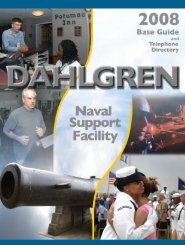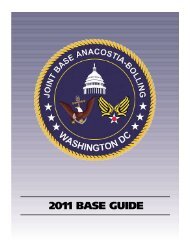About Naval Air Station Patuxent River - DCMilitary.com
About Naval Air Station Patuxent River - DCMilitary.com
About Naval Air Station Patuxent River - DCMilitary.com
You also want an ePaper? Increase the reach of your titles
YUMPU automatically turns print PDFs into web optimized ePapers that Google loves.
12<br />
“A great responsibility is put into your<br />
hands, for growth and change is still the very<br />
life of any air service which hopes to survive.<br />
I look to <strong>Patuxent</strong> <strong>River</strong> to carry a large part<br />
of the burden of ensuring that quality,<br />
imagination and resourcefulness are all<br />
included in our future equipment and in its<br />
typical use. You have the chance to make a<br />
great reputation...”<br />
Rear Adm. John S. McCain,<br />
Commissioning Day, April 1, 1943<br />
<strong>Naval</strong> Aviation’s<br />
Early Years<br />
The Navy and Marine Corps began<br />
flying aircraft in 1911 and 1912, and<br />
there has never been as many aviation<br />
functions at one facility as there are<br />
now at <strong>Patuxent</strong> <strong>River</strong>. Why is there a<br />
naval air station at Pax <strong>River</strong> and what<br />
is so much of naval aviation doing<br />
there? A look at history shows that the<br />
size and location of naval aeronautics<br />
infrastructure has always been a<br />
function of technological development<br />
and defense requirements.<br />
For as long as the Navy and Marine<br />
Corps have flown aircraft, some<br />
organization has been charged with<br />
Our Rich Heritage<br />
Our Rich Heritage<br />
developing, procuring and maintaining<br />
the platforms. During the first 10 years<br />
of naval flight, from 1911 to 1921, this<br />
responsibility was split among several<br />
Navy bureaus. For example, the Bureau<br />
of Construction and Repair was responsible<br />
for airframes, the Bureau of Steam<br />
Engineering for engines, the Bureau of<br />
Navigation for instruments and the<br />
Bureau of Ordnance for air-launched<br />
weapons. Navy offices in the<br />
Washington, D.C., area were located at<br />
the Navy Yard in Anacostia and in the<br />
Army-Navy State Building which is now<br />
the Old Executive Office Building on<br />
Pennsylvania Avenue.<br />
<strong>Naval</strong> aviation was a small-time affair<br />
and required only small quarters. Each<br />
bureau devoted scarcely more than one<br />
desk to aviation, and for some officers<br />
aviation was collateral duty. The first<br />
director of <strong>Naval</strong> Aeronautics, Capt.<br />
W.I. Chambers, was assigned by the<br />
Secretary of the Navy to the Bureau of<br />
Navigation. After reporting for work the<br />
new director listened to the chief of the<br />
bureau explain that office space was<br />
extremely tight and suggested he do<br />
some of his work at home.<br />
<strong>Naval</strong> aeronautics remained a small<br />
operation until April 1917 when the<br />
United States declared war on<br />
Germany. During the next 19 months<br />
the requirements of war and the vast<br />
defense expenditures swelled the<br />
Navy’s aircraft inventory from 54 to<br />
2,107. Many air stations were established,<br />
most of them capable of at least<br />
some level of maintenance. In<br />
Washington, D.C., Congress appropriated<br />
money for a temporary building to<br />
house the Navy Department offices that<br />
were rapidly expanding beyond the<br />
capacity of the crowded Army-Navy<br />
State Building. The new structure was<br />
built on the south side of Constitution<br />
Avenue west of 17th Street and was<br />
known simply as the ‘Main Navy<br />
Building.’ In Pennsylvania, on the<br />
property of the Philadelphia Navy Yard,<br />
the Navy built a facility dedicated to the<br />
design and construction of aircraft, the<br />
‘<strong>Naval</strong> <strong>Air</strong>craft Factory.’ The first aircraft<br />
built there made its first flight in<br />
March 1918.<br />
When the war ended, defense<br />
spending declined to its pre-war levels<br />
but the temporary building on<br />
Constitution Avenue gained permanence.<br />
<strong>Naval</strong> aeronautics had demon-


